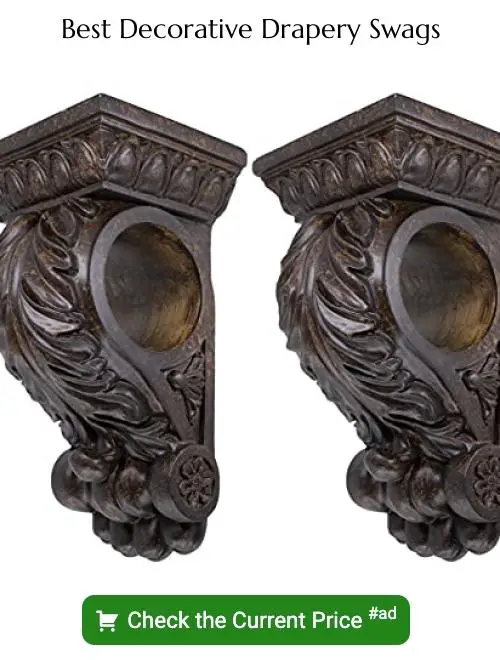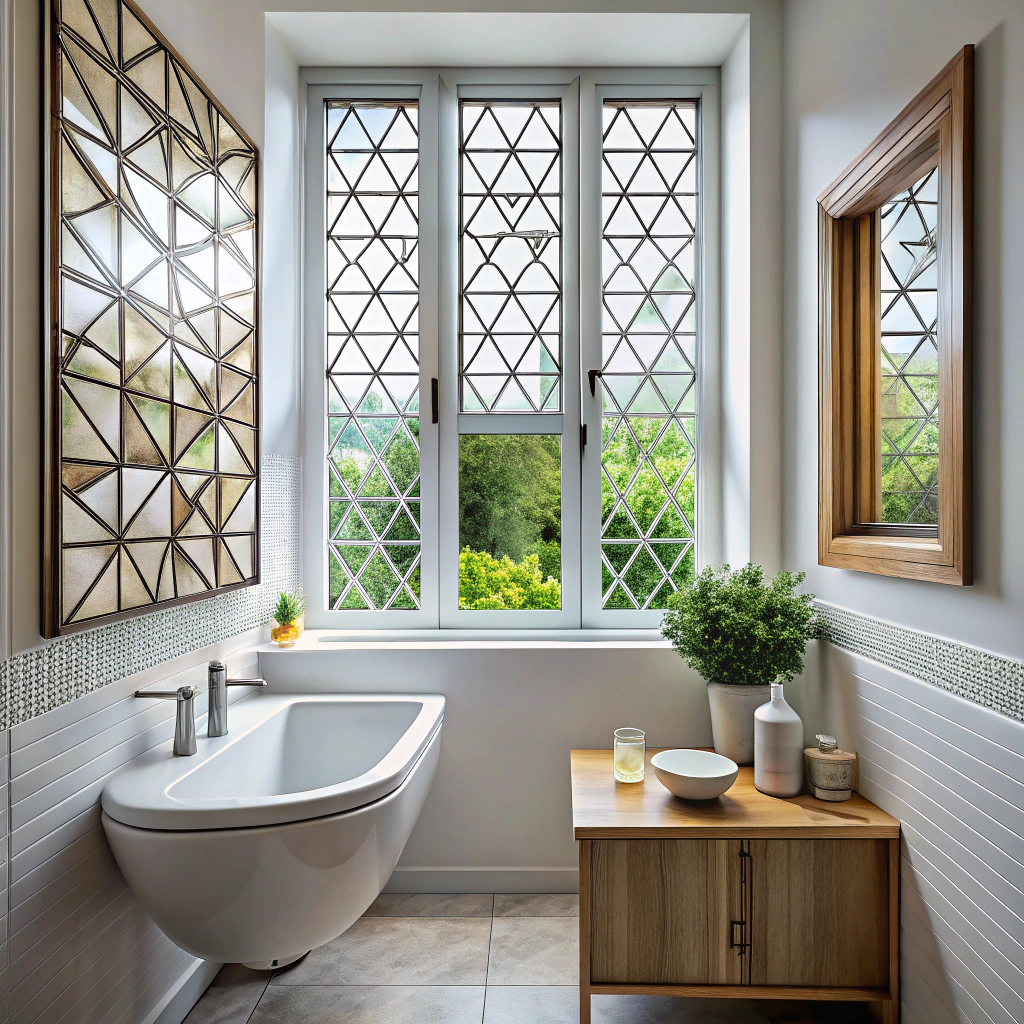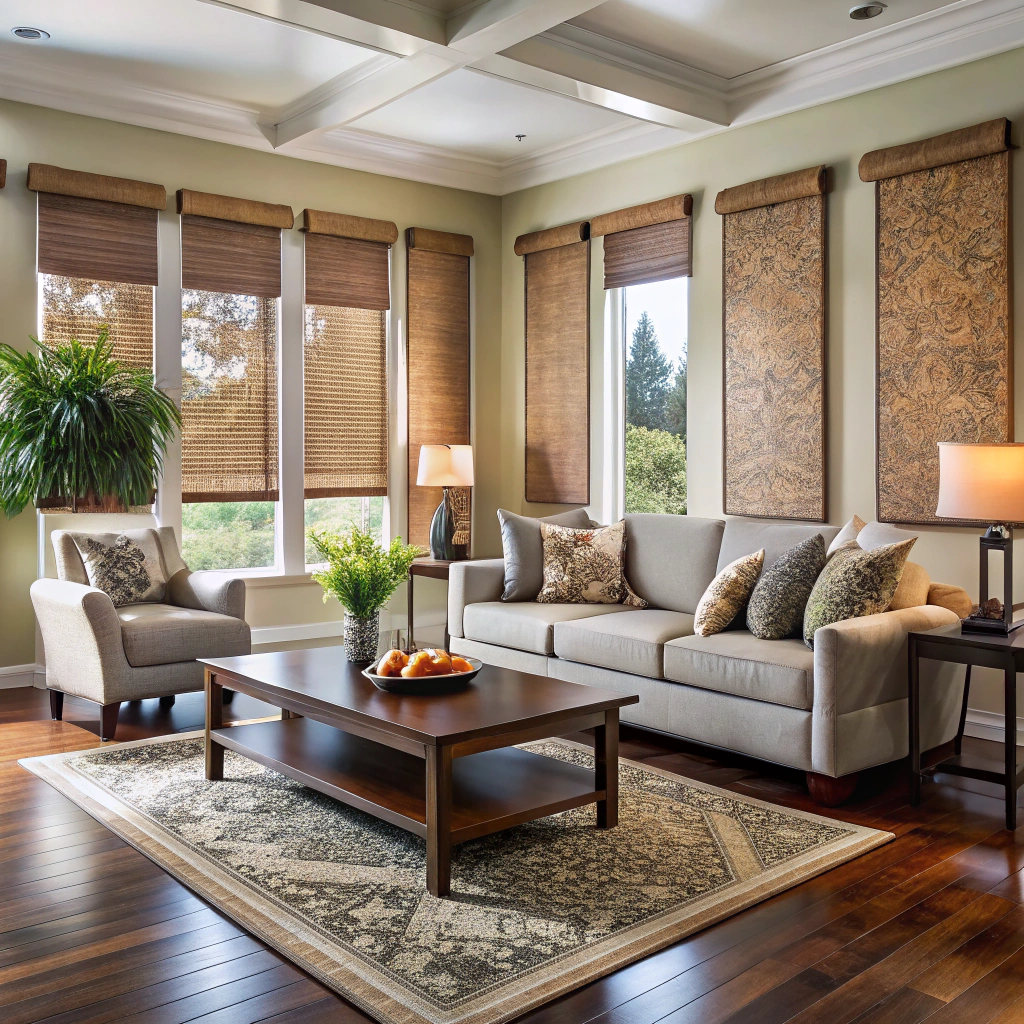Explore the transformative power of drapery swags because their distinct aesthetics and versatility can redefine your window treatments.
Key takeaways:
- Swags are unstructured, semi-circular fabric window treatments.
- They can be used alone or combined with other coverings.
- Swags come in various types, including traditional, scarf, and pole swags.
- Fabric selection is important for weight, pattern, and durability.
- Accurate measuring and proper hardware selection are crucial for installation.
Definition of Drapery Swags
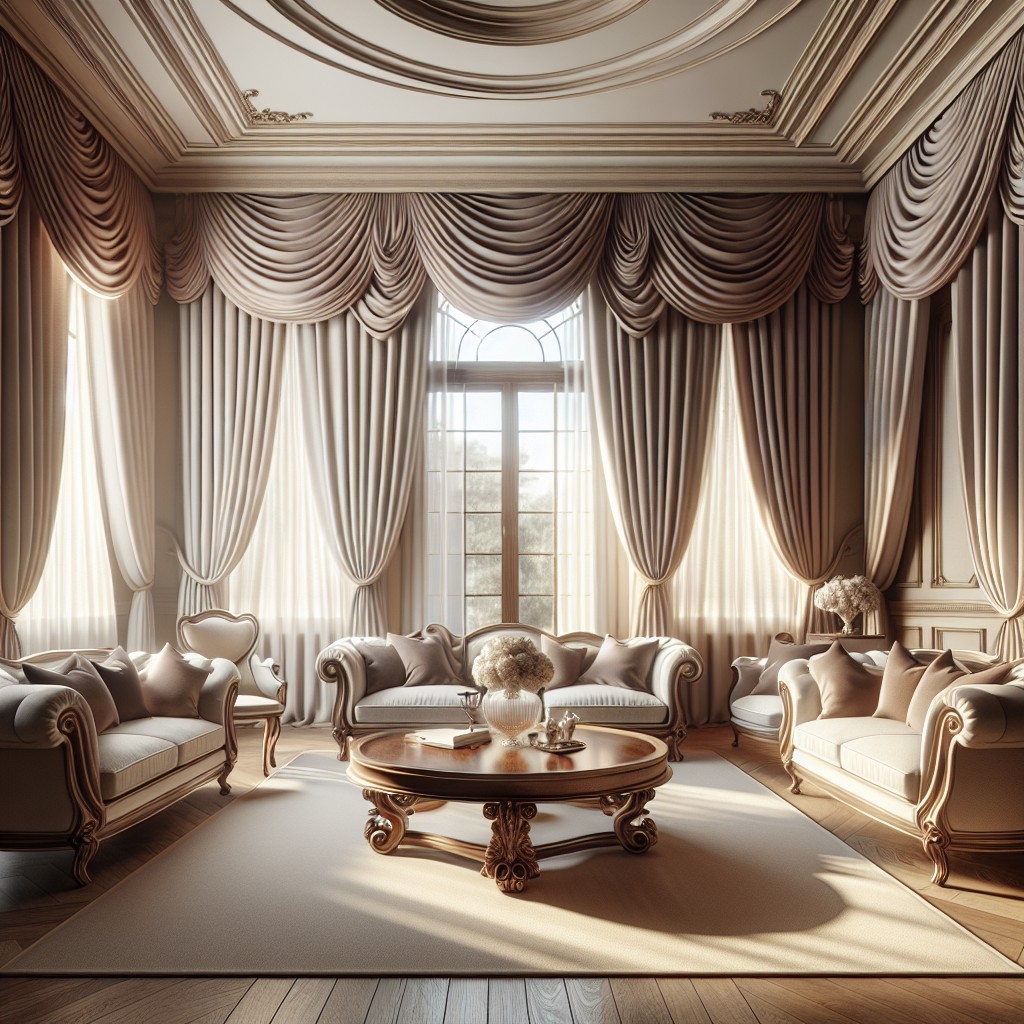
Drapery swags are a form of window treatment featuring fabric that elegantly drapes across the top of a window, often in a semi-circular shape. This decorative element can add sophistication and a classic touch to the overall aesthetic of a room. Swags can be used alone or combined with other window coverings like panels or blinds. They are versatile in design, allowing for customization through various fabrics and patterns to complement any decor style.
- Swags are characteristically unstructured, softly draping down either side of a window, creating a curve that frames the top.
- They do not cover the window fully, often leaving much of the glass exposed for natural light to infiltrate the room.
- Swags can hang from poles, rings, or be mounted on boards depending on the desired look and the support structure in place.
- They offer a balance between decoration and functionality, with the ability to introduce color, texture, and pattern to a space without being overly obtrusive.
Types of Drapery Swags
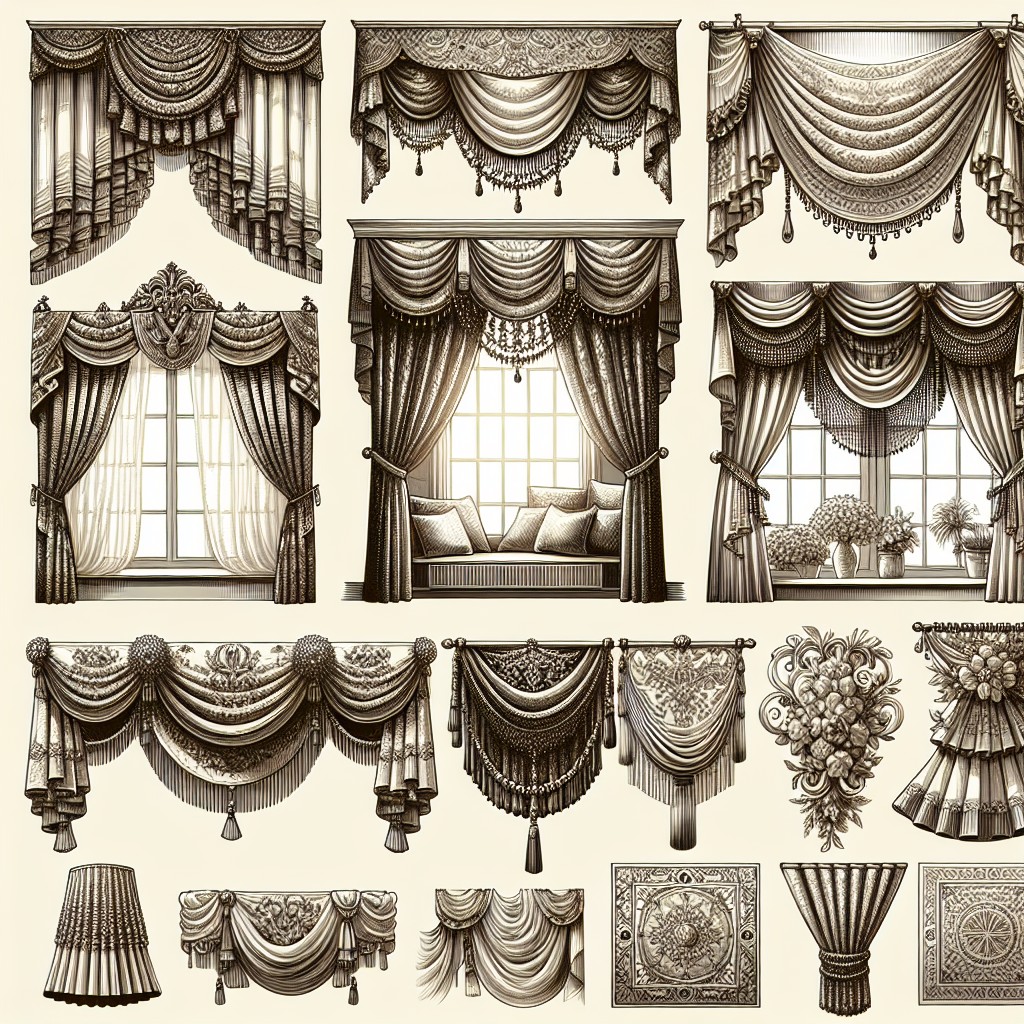
Swags come in a variety of styles to suit different interior design themes and window shapes. The most common types include:
- Traditional Swags: These feature a soft, curved hump and tails that flow down on either side of the window, creating an elegant and formal look.
- Scarf Swags: A simple and versatile option, scarf swags drape loosely across the top of the window and can be adjusted for a casual or more dramatic effect.
- Pole Swags: These are draped over a decorative pole, with the fabric arranged in graceful folds, offering a more structured appearance compared to scarf swags.
- Jabot Swags: Incorporating vertical pleats or panels flanking the swag, jabot styles are often used for a classic and sophisticated ambiance.
- Modern Swags: With cleaner lines and less fabric, modern swags suit contemporary spaces and often pair with geometric shapes or minimalist hardware.
- Cascade Swags: Featuring multiple layers of fabric that cascade down the sides, these swags add depth and texture to window treatments.
- Balloon Swags: Ballooning out from the top, these provide a full, rounded look that can add a touch of romance to a room.
Each type lends a different mood and can be tailored to individual taste and the functional requirements of the room.
Fabric Selection for Drapery Swags
Choosing the right fabric is essential for achieving the desired look and functionality of your swags. Consider the following points:
- Weight and Drape: Heavier fabrics offer a more structured look, while lighter materials will drape softly. A fabric’s weight also affects its movement and ease of handling.
- Pattern and Texture: Select patterns that complement the room’s décor. Keep in mind that large patterns may be lost on smaller swags, whereas small patterns can be subtle on large swags. Texture adds depth and interest to the window treatment.
- Color Fastness: Ensure the fabric’s color won’t fade quickly by checking its lightfastness, especially if the window receives direct sunlight.
- Maintenance: Some fabrics require dry cleaning, while others are machine washable. Consider easy-care options for spaces used frequently.
- Durability: High-traffic areas benefit from sturdy fabrics that can withstand wear and tear.
- Lining: Adding a lining can provide extra body, improve insulation, and protect the fabric from sunlight. Consider a lined swag to enhance its appearance and longevity.
Remember, the fabric’s characteristics will significantly influence the swag’s aesthetics and performance. Take time to feel the materials and visualize them in your space to ensure the perfect match.
Measuring Window for Swags
Accurate measurements are crucial for ensuring your drapery swags look proportional and aesthetic. To begin:
1. Measure width: Start by measuring the width of your window. Include the frame and any additional width you want the swags to cover. Consider extending beyond the window frame for a fuller look.
2. Determine the drop: Decide how long you want the swag to hang down on either side of the window. This is known as the drop. A standard drop is roughly one-sixth of the window’s height.
3. Swag length: For the swag’s total length, double your desired drop length and add the window’s width. This allows fabric to drape gracefully.
4. Factor in fullness: Swags typically require more fabric for proper fullness and drape. A common recommendation is to multiply the window’s width by 1.5 to 2.5 times for the desired fullness.
5. Consider overlap: If you’re layering multiple swags, include an overlap measurement to ensure they intertwine without gaps.
Your measurements will guide the fabric yardage needed and ensure the swags fit your window size perfectly, creating an elegant window dressing.
Choosing the Right Hardware for Swags
Selecting appropriate hardware for swags is crucial for both aesthetic appeal and functional support. Consider the following when choosing hardware:
- Durability: Opt for sturdy materials capable of supporting the weight of your chosen fabric.
- Design Match: Match the hardware style and finish with the room’s decor and curtain fabric to create a cohesive look.
- Rod Size: The rod should extend slightly beyond the window frame on each side to allow for proper draping of the fabric.
- Installation Method: Ensure the brackets and hardware supplied are suitable for your wall type, whether it’s drywall, plaster, or masonry.
- Decorative Elements: Finials and holdbacks can add an extra touch of elegance. Pick designs that complement the swag’s flow.
- Ease of Use: Swag holders should allow for easy removal of the swag for cleaning without requiring the entire setup to be dismantled.
Always check the hardware’s load capacity before purchase to verify that it can bear your swag’s weight without sagging or becoming damaged over time.
Step-by-Step Instructions for Hanging Drapery Swags
Begin by identifying the main focal point of your window where the swag will drape the most. Mark this point lightly with a pencil.
Measure the width of your window and decide on the swag’s width. For a full look, aim for the swag to be two to three times wider than the window.
Install brackets on both sides of the window, ensuring they are level and aligned with your focal point mark. The height will depend on your preference for swag drop — the distance from the top of the window to the swag’s lowest point.
Place the swag fabric over the brackets, adjusting it to create a pleasing draping effect. The center of the fabric should align with your focal point.
Arrange the swag’s “tails,” the fabric that hangs down on either side, to gently cascade down.
Secure the fabric onto the brackets using tiebacks, pins, or holdbacks if desired, adjusting for symmetry and flow.
Fluff and arrange the swag to create even, elegant folds, ensuring the fabric drapes naturally and the lining, if any, is not visible.
Lastly, step back to visually confirm the swag is balanced and makes the desired decorative statement. Adjust as needed for the perfect finish.
Styling Tips for Drapery Swags
For an elegant look, keep the tails of your swags long and flowing. This creates a dramatic visual effect and adds a touch of sophistication to any room.
Balance is key when arranging multiple swags. Ensure they are evenly spaced and consistent in size to maintain a harmonious appearance across the window.
Play with color contrasts to highlight architectural features. Lighter swags against darker walls draw the eye and accentuate high ceilings or detailed molding.
Incorporate texture with your fabric choice. Velvets or silks give a luxurious feel, while linens or cottons offer a more casual, airy vibe.
Experiment with layering swags over blinds or shades for functionality and depth. This also allows for adjustable light control and added privacy.
Consider seasonal changes. Swags with fresh, light fabrics can brighten a room in spring and summer, while heavier materials add warmth during fall and winter.
For smaller windows, opt for simple, unadorned swags to avoid overwhelming the space. In larger rooms with ample wall space, more elaborate designs can be used effectively.
Remember, less is often more. A single, well-placed swag can be just as impactful as multiple layers, offering a clean and modern aesthetic.
Always step back and view your arrangements from different angles to ensure they look great from every perspective within the room.
Care and Maintenance of Drapery Swags
Regular dusting with a soft cloth or vacuuming with an upholstery attachment prevents accumulation of dirt and allergens. For deeper cleaning, consult the fabric care label; many swags can be machine washed on a gentle cycle, while others may require dry cleaning. Avoid bleach and harsh chemicals that can damage fabric or cause colors to fade. When ironing, use the appropriate heat setting to prevent scorching. If your swags are prone to wrinkling, consider a steamer for a gentle alternative to ironing.
In the event of small repairs, such as loose threads or minor tears, address them promptly to avoid further damage. Rotate swags periodically to ensure even exposure to sunlight, reducing the risk of uneven fading.
Common Mistakes to Avoid When Installing Drapery Swags
Incorrect measurements can disrupt the symmetry and flow of drapery swags. Always double-check the width and the drop of the swag before cutting any fabric.
Neglecting the fabric’s pattern alignment might lead to a disjointed aesthetic. Ensure that patterns match at the seams for a seamless look.
Overlooking the fullness ratio can result in swags that are too flat or overly bulky. As a rule of thumb, aim for a fullness ratio of 2:1 to 3:1 for an elegant drape.
Skipping the pressing of the fabric before installation can cause wrinkles that detract from the elegance of the swags. Press the fabric gently with an iron for a crisp, clean appearance.
Hanging the hardware too low might make the ceilings appear lower. Install hardware close to the ceiling to elongate the walls and elevate the room’s overall feel.
Using inadequate support for heavy fabrics can lead to sagging swags. Invest in sturdy hardware that can support the weight of the fabric you choose.
Layering Swags With Other Window Treatments
Layering swags with other window treatments can add depth, texture, and a professional touch to your windows. Consider the following points to achieve a harmonious look:
- Pair with Sheers: Hanging sheers beneath swags can offer a soft backdrop that diffuses light and provides privacy while the swags add a decorative frame.
- Coordinate with Blinds: Install blinds or shades for light control and privacy. The swags will soften the structured look of these treatments.
- Match with Panels: For a more traditional and formal appearance, hang drapery panels on either side of the window. The swags will act as a valance, creating an elegant top finish.
- Play with Patterns and Solids: If your swags have a bold pattern, pair them with solid-colored treatments to balance the look, or vice versa for a pop of pattern.
- Add Dimension with Textures: Combine different textures for a rich look. For instance, a velvet swag can be layered over linen drapes to provide contrast.
- Ensure Proportions: Keep the scale of patterns and the size of the treatments in mind to maintain visual balance.
Choose combinations that complement each other and your overall room décor for a cohesive aesthetic.
Inspirational Ideas for Drapery Swags
Transform your living space with draped fabric softening the harsh lines of window frames. Consider these inspirational ideas:
- Layer the swags with sheer panels for a touch of elegance.
- Use bold patterns to create a focal point in a room.
- Coordinate with the color scheme of your space for a cohesive look.
- For a regal touch, combine swags with rich velvet side panels.
- Embrace a casual charm with lightweight linen swags that billow gently.
- Introduce swags with tassels or fringe for a bohemian vibe.
- Create a seasonal display by changing the swags to match holiday decor.
- Pair with blinds or shades for privacy without sacrificing style.
Remember, the key to a beautiful swag is in how the fabric complements and enhances the existing decor. Experiment with textures, colors, and layers to discover the perfect swag style for your home.
Customizing Drapery Swags for Unique Windows
Tailoring drapery swags to unique window shapes transforms a standard treatment into a statement piece. With arched, bay, or unusually shaped windows, consider these points:
- Custom rods may be needed to follow the contour of non-standard windows; curved or flexible rods work well with arched shapes.
- Factor in the window’s architecture when determining the swag’s drop and sweep to ensure it complements, rather than clashes with, the window’s lines.
- For bay windows, separate swags for each section can offer a cohesive yet articulated look.
- Accentuate prominent features like a picture window with a wider central swag, flanked by narrower side swags.
- If dealing with an oversized window, reinforce the support system to handle the additional fabric weight without compromising the swag’s drape.
- Take into account the view and natural light; strategically place swags to frame the scenery and control illumination.
Keep balance in mind; a custom swag should enhance the window’s unique features without overwhelming it.
FAQ
What is a drapery swag?
A drapery swag is a piece of fabric loosely draped over a decorative rod or wound over a tieback at each corner of a window frame, used for adding style and a romantic touch to a room.
Are swag curtains still in style?
Yes, swag curtains are still in style, given they align with modern and current trends which prefer flat, tailored designs over outdated, over-the-top ruffles.
What’s the difference between a valance and a swag?
A valance is a top window treatment, while a swag, often pleated or gathered to form a half-circle shape, is a component of a valance that can sometimes be flat.
How are drapery swags installed?
Drapery swags are installed by first securing brackets on the wall above the window, then placing the rod on the brackets, and finally draping the fabric over the rod in a desired pattern.
Can drapery swags be used with blinds or other window treatments?
Yes, drapery swags can be used in conjunction with blinds and other window treatments to add an elegant aesthetic layer.
What types of materials are commonly used for drapery swags?
Common materials used for drapery swags include velvet, silk, linen, and chenille.
Recap
